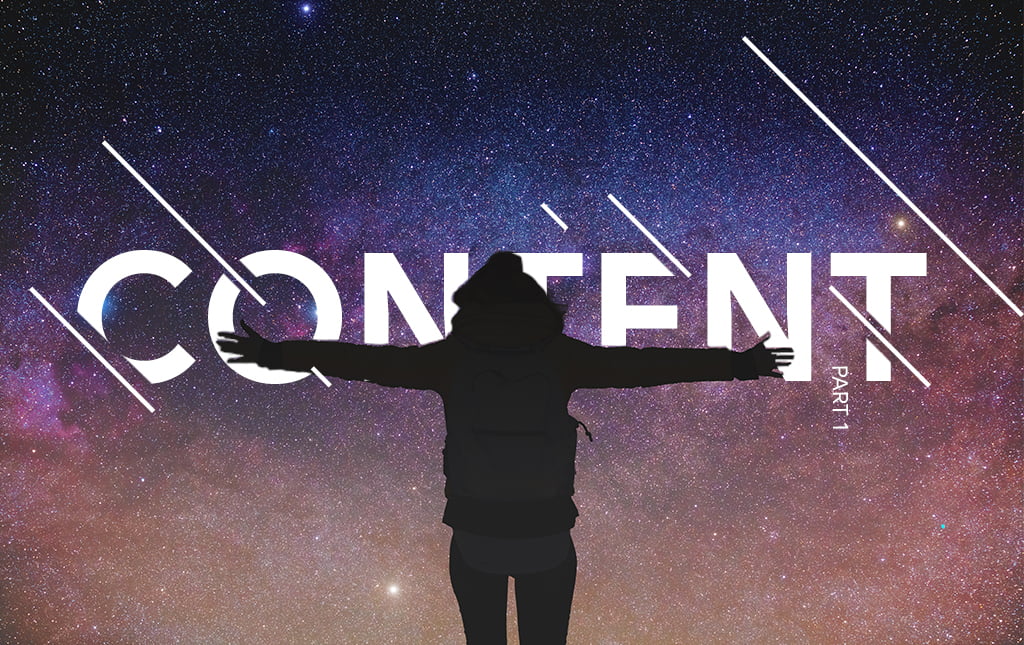Content strategy part II: black hole avoidance
Part I of this content mini-series discussed the what and the why of content strategies. Here, we’re going to talk about how to put it into practice and start building a strategy.
Diving into black hole avoidance…
Bearing in mind our night sky analogy (North Star = website. Cluster stars = auxiliary content. Shooting stars = creative campaigns), we’ve detailed the next steps we recommend you take to building a content strategy.
Word count limitations have meant we’ve gone quite top-level (we think shorter is sweeter with blog content, but it’s highly debated!), so if there’s anything we haven’t answered, or you have burning questions, please do get in touch and we’d be delighted to provide more information.

Set goals
We recommend setting overall content marketing goals that you want your strategy to answer (these are more in line with business goals). These should be kept in mind when building your strategy, to ensure every piece is feeding into those overall goals in some way.
Then you also need to set specific goals for each piece of content you create. Think about:
- Rankings
- Prospecting
- Sales
- Site traffic
- Site engagement
- Brand loyalty
- Brand authority
- Customer loyalty
- Market share
Perhaps you’ve noticed your site is underperforming, with particularly high bounce rate on your product pages. So you decide on a product content review. Your goal is to lower bounce rate, with a long-term goal of higher conversion.
The next step is to analyse the content – how are you presenting and selling? Talk to your customers about what they want to know, look at what your competitors are doing, get feedback from people with fresh eyes.
Utilise keyword research
Undertake keyword research to find out what users actually want to know. As Google’s algorithms become ever more like human thought-processes, keyword research is becoming more and more intuitive. The dark days of keyword stuffing are long gone, and your priority must always be to serve the user first, not Google. Because ultimately, that’s Google’s aim too.
With keywords, as long as your content is highly relevant, digestible, and engaging, Google is smart enough to understand without the need for signpost keywords.
However, keywords are a fantastic tool for helping you discover what questions people are asking. Use keyword research to inform your content creation by aiming to answer those questions. Discover what Google values by inspecting those in the top Search Engine Results Pages (SERPs) positions for those keywords. Then feed them into your schedule.
Plan resource and launch dates
Then tackle the content. Be clear and transparent. Be to-the-point, but answer specific questions. Interlink between pages (especially from blog content to product pages) to share user signals and boost page authority.
Segment the copy so it’s easy to digest across mobile, tablet, and desktop. Think about whether a video or animation would be relevant and would help you to better sell your product.
Decide on the best date to go live – when is your peak period? You ideally want your new content to be live and settled a few months before peak to ensure there are a) no teething issues during your busiest time and b) Google’s had a chance to crawl the new content and index it accordingly.
Your content strategy should be a constant process of evolution and refinement.
Set up content measurement
Set up a monthly report where you routinely pull statistics from Google Analytics to understand how your content has performed over the month.
For content analysis, we would recommend:
Analytics
- URL
- Page type
- Date launched
- Bounce rate
- Time on page
- Pages per visit
- Conversion rate (for product pages)
- Channel acquisition
Refine and evolve
Once you’ve pulled the data each month, take the time to really look at the data. What are you seeing, and what does it mean for your user, and thus your content?
A high bounce rate and high time on page could highlight that users are reading the content, but aren’t finding a clear CTA or next step for their journey so are leaving the site. It’d also be worth setting up ‘scroll’ as an interaction in Analytics.
If email acquisition has far higher pages per session or conversion rate than other channels, what else can you be doing on email? Have you considered a newsletter to build brand loyalty and promote underperforming blog posts?
Once you give yourself the space to think about content performance (we know, we know, that feels impossible) you’ll really start to think about how every piece is being interacted with. You can then feed that into the next pieces of content you create, or go back to a piece that hasn’t done what you wanted it to, and refine or build it in a new format.
ifour helps clients build their content strategies to inform, engage, and delight their customers. If planning or generating engaging copy has you feeling like Atlas, straining under the weight of the sky, give us a call (01892 541 111) or pop us email (hello@ifour.co.uk). We’d love to help.


